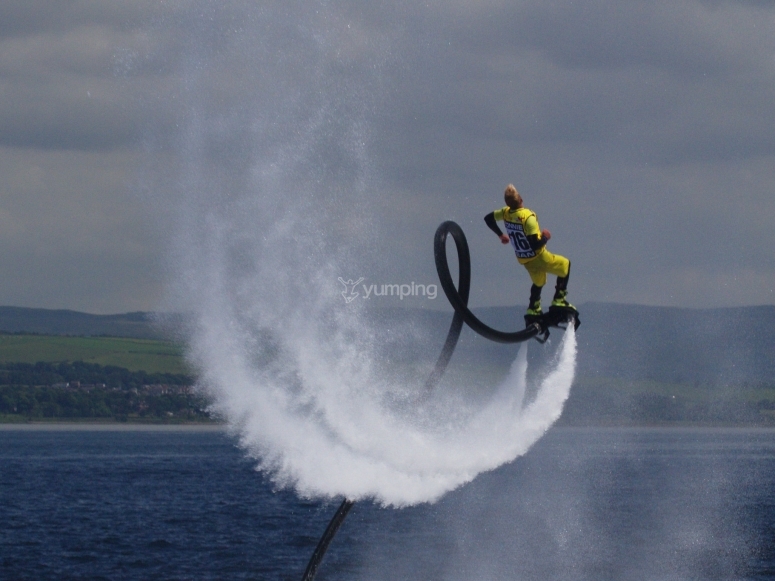
WHAT IS IT?
The Flyboard is actually just one example of a wider trend in watersports – hydroflighting. The basic concept is the use of jets of water that propel a craft into the air. The Flyboard itself is a stand-on-top, one-person model that resembles a snowboard with two large apertures, set wider apart than the footstraps on the board, where the jets emerge. The force of the jets provides enough lift to shoot the rider up to at least 10 metres high (heights of over 20 metres have also been claimed) and allows them to perform stunts like backflips, frontflips and spins.
The patent for the Flyboard is actually over 10 years old, having been acquired by French watersports expert Franky Zapata in 2012. It immediately caught the attention of those in the know, but it hasn’t yet taken off as a challenger to established watersports such as paddleboarding or powerboating. Perhaps the hefty price tag of at least several thousand pounds per unit has put a dampener on that.

HOW DOES IT WORK?
Now, we’ve mentioned jets and you might be thinking that jet propulsion is nothing new in watersports - look at the PWC (personal watercraft), also known as the jet ski. Well, you'd be right on the money. Flyboards, and similar devices, rely on jet skis for power. A Flyboard, or other hydrojet hoverboard, is connected to a jet ski by a heavy-duty hose that captures the high-pressure stream of water and transfers it to the platform that the user stands on. In this way, it’s the jet ski pilot who controls the throttle, and so the power, of the Flyboard.
What’s new in the Flyboard is the stabilisation. This is achieved by the rider using hand-held hoses to keep their balance. It’s a necessary feature for beginners, but experienced pilots can do without them, giving them more power to the main jets and greater freedom for acrobatics.

WHERE CAN YOU DO IT?
Flyboarding started in France, and it’s no doubt that the south coast of France, as well as other Mediterranean locations such as southern Spain, the Balearic Islands and Santorini, are excellent places to try this sport. Further afield, there’s the Caribbean, and the surfing coasts of California and Australia.
What about here in the UK? As an island nation, it’s no surprise that there are Flyboarding experiences available in every part of the UK. In the Southwest, you can try Flyboarding in Poole Harbour, Dorset. The closest options to London are in Salfords, Surrey. Dumfries, in Scotland is another location, as are the Tattershall Lakes in Lincolnshire and Jersey in the Channel Islands. And that’s not to mention Ireland, where you can get on a Flyboard in the Atlantic Ocean in Kilkee, County Clare.

WHAT NEXT?
As far as we can see it, hydroflighting is set to take off when the prices start to come down. Flyboards and other models, including the Freedom Flyer, the Jetblade and the Flydive X-Board, have an irresistible attraction for all kinds of people. Perhaps it’s the fact that they have to be tethered to a jet ski that’s currentñy putting people off? We shall see.
If the tethering aspect is going to be a problem, we need look no further than Franky Zapata’s latest innovation, the Flyboard Air. This is a seriously sci-fi piece of kit, made up of a board mounted with 5 jet turbines. They propel air in this model, not water, and allow the user to fly like Superman, or maybe the Silver Surfer is a better comparison. Zapata himself has even crossed the English channel with just one stop to refuel on the way. Once again, however, it seems the price tag (hundreds of thousands of pounds this time) and some of the technical limitations might stop the Flyboard Air from reaching mass appeal - but watch this space!
















